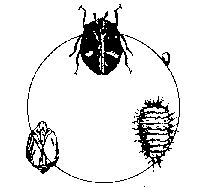Insects-so small you hardly notice them-may be doing damage to
garments and other textile items around your home. Generally, you aren't
aware of them until its too late. And the babies are the culprits-eating
their way through your sweaters, jackets, and pants, or wool rugs and needlework
as they mature. Their mothers and fathers do no damage-except to leave
behind their eggs from which the hungry larvae hatch.
Most people know that clothes moths can do considerable damage, but
carpet beetles can cause extensive damage if they are not controlled. Clothes
moth larvae are usually found on their food material. Carpet beetle larvae
are more adventurous and may crawl from one room to another, or from one
apartment to another. They also can be found in bird and rodent nests.
Habits
Mature insects deposit eggs in a variety of locations-clothing, upholstery,
rugs or carpet, toys, animal skins or trophies, and even natural-bristle
brushes. As the eggs hatch, the larvae begin to feed on animal-based materials:
silk, wool, feathers, and leather. They also have been known to eat fabrics
blended with wool and items soiled with food stains or body oils.
Eggs and larvae of moths and beetles can be carried into homes on articles
containing wool or other animal fibers. Items such as secondhand furniture,
upholstered furniture, and other home furnishings can be home for these
pests. Clothes moth eggs or larvae also can hide in woolen fabrics or rugs.
Adult clothes moths prefer darkness and quickly hide when they are disturbed.
Clothes moths are not the moths seen flitting about lights. Adult clothes
moths are about 1/2 inch long and light tan in color. They have narrow
wings and prefer darkness.
Adult carpet beetles are attracted to the sunlight and are known to
feed outdoors on pollen of flowers. The most common adult carpet beetles
are small, oval-shaped insects that are black with varied patterns of orange
and white. They are sometimes mistaken for common garden lady beetles because
of their similar size and shape.
Two types of clothes moths damage textile items. Casemaking clothes
moth larvae (cream-colored caterpillars less than 1/2 inch long) spin protective
cases incorporating pieces of the items they are eating. The cases, which
they drag along as they move, eventually become tough cocoons in which
the insect pupae develop into adult moths. Webbing clothes moths spin a
silken web to form feeding tubes that they attach to the item being eaten. See fig. 1.
Fig. 1
 |
|
Webbing clothes moth
Casemaking clothes moth
Tineola bisselliela (Hummel)
Tinea pellionella (Linneaus)
|
|
Carpet beetle larvae (about 1/8-1/4 inch long and covered with hairs
or bristles) do not spin webs or make cocoons. (fig. 2) As they mature,
they shed their skins, which look like living larvae. Carpet beetles crawl
from place to place as they eat, but may be found in areas that do not
provide any food. Fecal pellets are found where beetles have been feeding.

|
Fig. 2. The life cycle of the carpet beetle. Carpet beetles
undergo complete metamorphosis. The adult lives 20 to 60 days and lays
30 to 100 eggs, which hatch in 6 to 20 days. The larva lasts 60 to 325
days. Both the larval and adult stages damage fabric. (Actual size of adult
1/10-1/3 inch, or 2.5-5 mm). |

